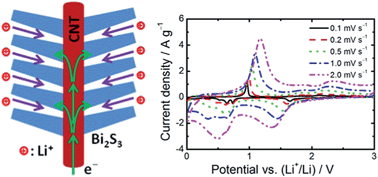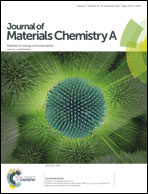Branch-structured Bi2S3–CNT hybrids with improved lithium storage capability†
Abstract
Bismuth sulfide (Bi2S3) is a promising Li-storage material due to its high gravimetric and volumetric capacities. However, this intrinsic merit has often been compromised by the poor cycle and rate capability due to the lack of structural integrity upon the Li insertion/extraction process. Here, we engineer a branch-structured bismuth sulfide–carbon nanotube (CNT) hybrid by growing Bi2S3 nanorods onto CNTs to mitigate this issue. The hierarchical Bi2S3–CNT hybrids possess high surface areas, rich porosity for electrolyte infiltration, and direct electron transport pathways, and can be employed as efficient electrode materials for Li storage. These electrochemical results show that the Bi2S3–CNT hybrid exhibits a high reversible capacity (671 mA h g−1 at 120 mA g−1), stable cycling retention (534 mA h g−1 after 90 cycles), and remarkable rate capability (399 mA h g−1 at 3000 mA g−1), notably outperforming other reported Bi2S3 materials. Such superb Li storage capabilities suggest that the Bi2S3–CNT branches could be potential electrodes for rechargeable batteries.

- This article is part of the themed collection: 2014 Journal of Materials Chemistry A Hot Articles

 Please wait while we load your content...
Please wait while we load your content...